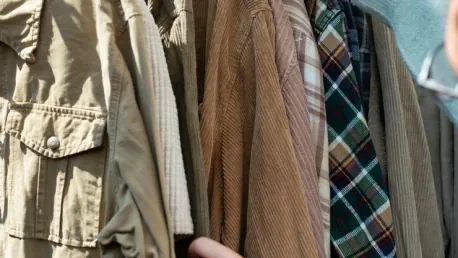The impressive expansion of the U.S. secondhand apparel market has been propelled by a blend of shifting consumer preferences, especially among Gen Z and millennials, and advancements in AI technology. Reports and studies from leading resale platforms, such as ThredUp, reveal substantial growth and promising future projections. This article delves into how these elements, along with the economic and market influences, are driving both online and in-store resale activities.
Evolving Consumer Behavior
Shift Towards Secondhand Clothing
In 2024, the U.S. secondhand apparel market recorded a robust 14% growth, significantly outpacing the broader retail clothing market by five times. Such an increase marks its strongest annual growth since 2021, highlighting a noticeable shift in consumer behavior toward secondhand clothing. This surge is particularly prominent among younger generations, with Gen Z and millennials leading the charge in adopting pre-owned apparel. This demographic is becoming increasingly conscious of both environmental sustainability and cost efficiency, propelling them toward alternatives that reduce waste and offer more affordable options.
The evolving trend towards secondhand clothing isn’t just a fleeting fashion statement; it marks a deeper shift in values. As younger consumers become more aware of the environmental impact of fast fashion, they are aligning their purchasing decisions with sustainability principles. By opting for preloved garments, they not only contribute to reducing waste but also promote a circular economy, where clothing is reused and recycled. This commitment to sustainability is significantly impacting the overall market, giving rise to a demand for quality secondhand clothing that aligns with modern ethical standards.
Increased Budget Allocation for Resale
Insights from ThredUp’s 2025 Resale Report emphasize a dynamic change in spending trends. Data reveals that 46% of Gen Z and millennials plan to allocate nearly half of their apparel budget to secondhand items over the next year. This trend underscores a growing preference for pre-owned garments driven by economic considerations and a heightened focus on sustainability. Economic factors such as tighter budgets and inflationary pressures have made secondhand options more appealing to these younger generations, who seek both value and quality in their purchases.
Moreover, this inclination towards secondhand shopping is not merely driven by financial constraints; it also reflects a shift in fashion sensibilities. Preloved clothing offers unique and often vintage pieces that allow consumers to express their individuality. This trend is further amplified by social media influences, where showcasing unique, thrifted outfits has become a cultural phenomenon. Retailers are recognizing this shift, and as a result, many are expanding their resale offerings to meet the growing demand, ensuring that their efforts align with contemporary consumer expectations.
Technological Advancements Propelling the Market
Role of Social Commerce
Social commerce has emerged as a significant trend, reshaping how consumers purchase secondhand apparel. Over the past year, 39% of Gen Z and millennials have made secondhand apparel purchases via social commerce platforms such as Instagram and Facebook. This method of shopping integrates seamlessly with their digital lifestyles, allowing them to discover and buy items directly through social media. Retailers are increasingly incorporating social commerce strategies into their sales models, understanding its potential to drive significant resale adoption.
The integration of social commerce platforms into the resale market creates an interactive and engaging shopping experience. It allows consumers to not only purchase items but also share their finds, creating a social loop that promotes further engagement. The visibility of secondhand fashion on these platforms also helps normalize and popularize the concept of buying pre-owned clothing. Retailers are leveraging this trend by creating visually appealing and easily navigable online stores within social media apps, facilitating effortless transactions and expanding their customer base.
Enhancing Experiences with AI
Artificial intelligence is playing a transformative role in the secondhand apparel market, significantly enhancing the shopping experience. According to recent surveys, nearly 59% of millennials and Gen Z find that AI-driven personalization and improved search functionalities make shopping for secondhand items just as straightforward as buying new. AI tools aid in curating personalized recommendations, improving product discovery, and optimizing the user experience, making secondhand shopping more accessible and appealing to a broader audience.
Retailers are heavily investing in AI technologies to bridge the gap between new and secondhand shopping experiences. By implementing AI-driven tools, they can offer personalized shopping experiences that cater to individual preferences, thus making the process of finding the perfect secondhand item more efficient and enjoyable. This technological advancement is crucial for maintaining competitiveness in the market and attracting tech-savvy younger generations. AI’s ability to streamline operations, such as inventory management and price optimization, further underscores its importance in the evolving landscape of secondhand retail.
Economic and Market Influences
Impact of External Factors
Economic factors, particularly potential tariff increases and changes in trade policies, hold significant influence over consumer behavior in the apparel market. In response to potential rises in apparel costs due to new government policies, 69% of millennials indicated they would turn to secondhand options as more affordable alternatives. This trend reflects a strategic consumer shift aimed at mitigating the financial impact of external economic pressures. The anticipation of inflation and higher clothing prices is propelling the secondhand market into a position of resilience and continued growth amidst such uncertainties.
Additionally, economic challenges highlight the need for sustainable consumer practices. Secondhand shopping offers a practical solution for cost-sensitive consumers who are equally concerned about environmental issues. As millennials and Gen Z prioritize eco-friendly purchasing decisions, they are more likely to consider secondhand apparel first, making it a preferred choice during economic hardships. This shift not only benefits consumers but also builds a more sustainable fashion industry, one that can adapt to and thrive despite external economic shocks.
Retailers’ Strategic Adaptations
Retail executives are increasingly acknowledging the growing consumer participation in resale activities, leading them to adapt their strategies to meet this demand. With 94% of retail executives recognizing customer involvement in resale, they are taking proactive measures to reduce reliance on imported goods and enhance their resale offerings. This strategic shift aims to provide a stable source of apparel inventory, offering protection against potential supply chain disruptions caused by tariffs and trade fluctuations.
The move towards embracing resale also aligns with broader industry trends aiming for sustainability and ethical consumption. By incorporating secondhand apparel into their business models, retailers not only cater to changing consumer preferences but also position themselves as responsible and forward-thinking. This adaptation involves investing in efficient logistics for handling preloved items, innovative marketing strategies to promote resale, and leveraging technology to ensure seamless integration with traditional retail operations. These efforts contribute to creating a robust and adaptive retail environment that can sustain and capitalize on the growing secondhand market.
Future Projections and Industry Outlook
Anticipated Market Growth
The future projections for the U.S. secondhand apparel market are nothing short of promising. The market is forecasted to reach a substantial $74 billion by 2029, with expectations for online resale alone to hit $40 billion. This anticipated growth represents a compound annual growth rate of 13%, underscoring the sector’s dynamic expansion. The continuous rise in consumer inclination towards secondhand items, driven by both economic and environmental considerations, suggests a sustained upward trajectory for the market.
As secondhand shopping becomes increasingly popular, retailers are expanding their platforms and offerings to capture this growing segment. The integration of more user-friendly online marketplaces, combined with brick-and-mortar thrift stores, caters to a diverse range of shoppers. These hybrid models enhance market reach and provide consumers with multiple avenues for purchasing pre-owned apparel. The projected growth highlights the shift towards a more circular economy, where resale and sustainable consumption practices are at the forefront.
Innovations Driving Forward Momentum
The significant growth of the U.S. secondhand apparel market has been driven by a mix of changing consumer preferences, particularly among Gen Z and millennials, and innovations in AI technology. Reports and studies from top resale platforms, such as ThredUp, indicate substantial growth and optimistic future forecasts. This development is largely attributed to the younger generation’s desire for sustainability, affordability, and unique fashion finds. Additionally, advancements in AI have streamlined operations, improving inventory management and personalized shopping experiences. This has made secondhand shopping more accessible and appealing to a wider audience. The economic benefits and market influences also play a crucial role in this trend. As the online and physical resale markets continue to thrive, traditional retail may need to adapt to stay relevant. This article explores how these various factors—consumer behavior, technology, and economic conditions—are driving the robust momentum in both online and in-store resale activities.









